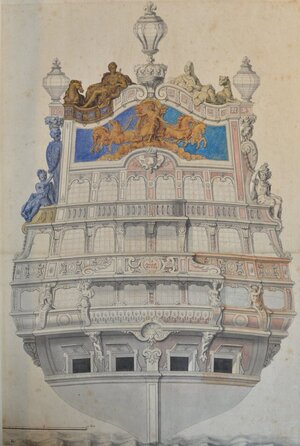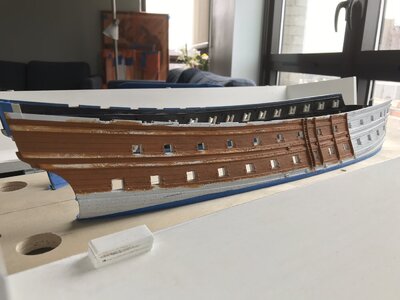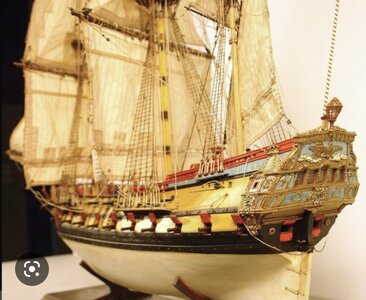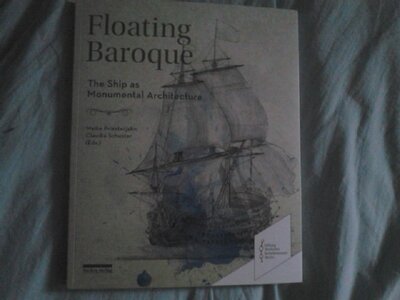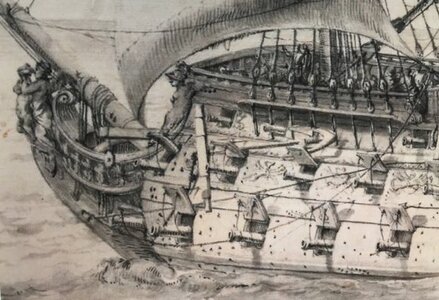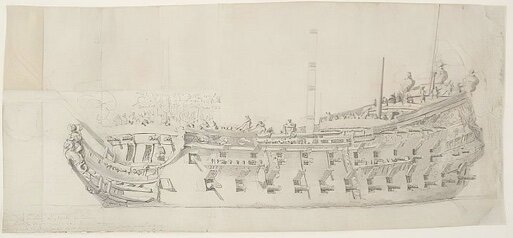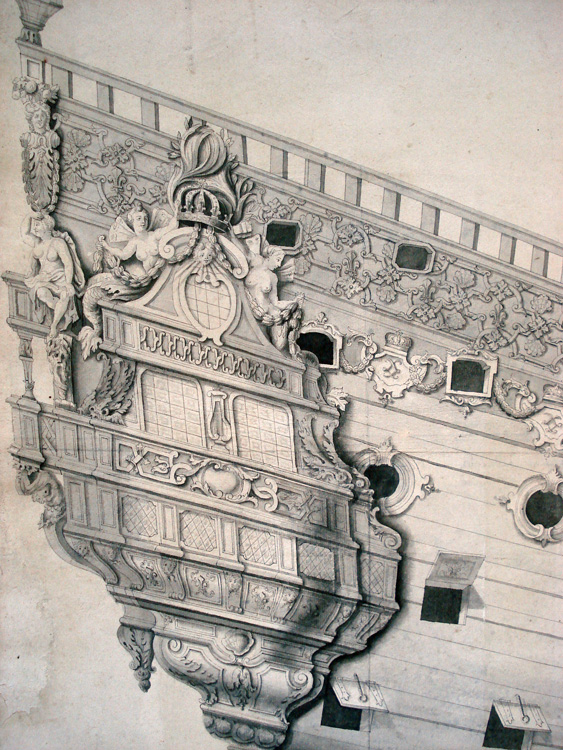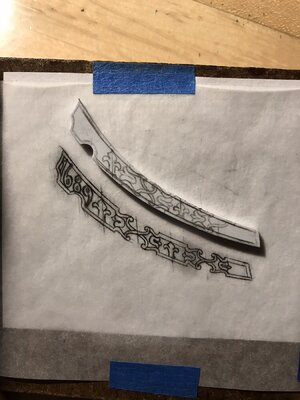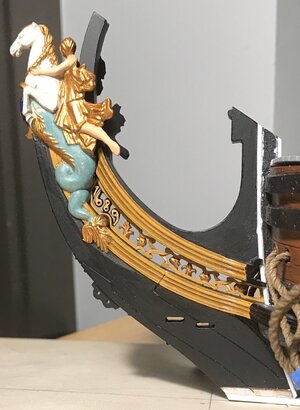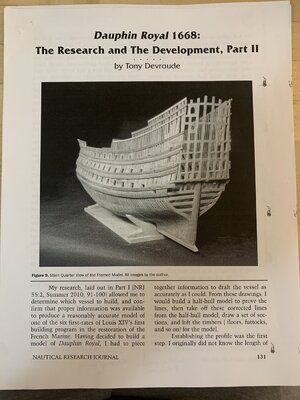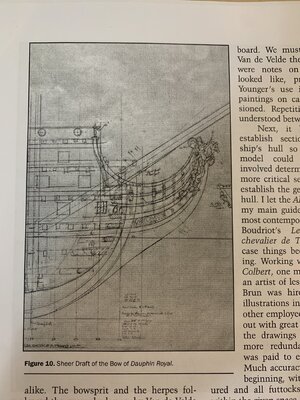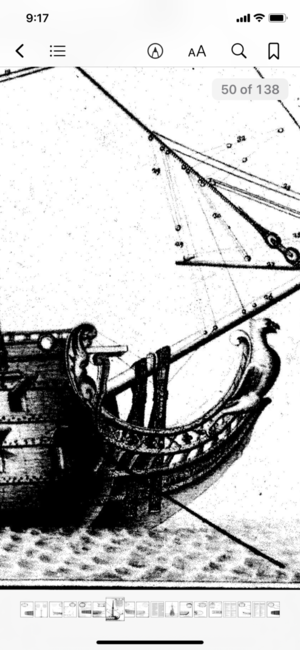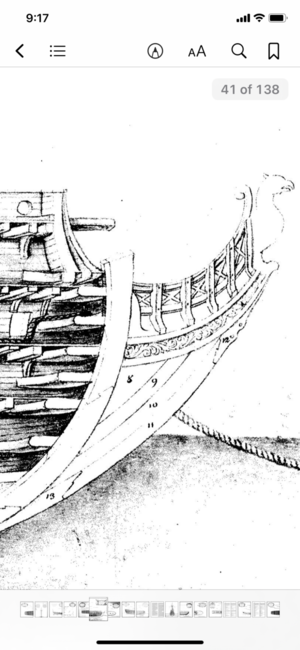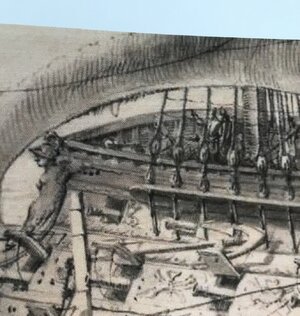The following is excerpted from D.M.J. Henry, Sur la Vie et Oeuvres de P. Puget, published in 1853. It is not annotated in the modern sense, and the author only mentions his indebtedness to a friend of his at the archives, who uncovered the following description of SR as she first was:
it is a duty and a real pleasure to express to this laborious writer all my gratitude for the obliging competition which he has kindly lent me by searching, in the archives of the Ministry of the Navy, the documents which could not be furnished to me by the archives of the port of Toulon, and sending me textually a copy of the various pieces of Colbert's official correspondence which I use in this work.
—
To this seems to be reduced the apparent modification made in the profusion of ornamental riches, the composition of the painting always retaining a great and noble character. It may be, however, that the absence of ornaments in the vault was less akin to the modification demanded by the minister, than to the quality of the vessel, which being of second rank did not admit so much luxury of decoration. The area that bears the name of the vessel, covered with beautiful arabesques, is, at the Sun Royal, supported by four baths indicating the seasons that the star of the day shares in its annual race, because it must be noted, everything is allegorical in the decoration of this building whose name itself alluded to the young monarch. The succession of seasons begins with the left, where winter is represented under the appearance of an old man wrapped in a drapery covering his head and body; the other three seasons are graceful figures of women carrying on their heads a basket full of flowers or fruits that characterize them. The gallery extends from one end of the stern to the other, and its two extremities serve as the seat of two beautiful figures representing warriors of lesser proportions than those of the first vessel. These warriors, whose defensive armor differs as well as attitude, still refer to the two great regions that the sun illuminates. The east, on the starboard side, had its helmet adorned with floating ostrich feathers, while the crest of the port warrior, composed of feathers of other birds, formed a broad plume framing with great taste all the top of the head . With the hands of the two hands, which were near the ship, on the cornice of the gallery, which served as their seat, both of them held up the arm on the opposite side, so that the hand served as support.
P. PUGET. 39
next to the top of the board. These sides are formed of an inverted console whose notch accommodated at the reentrant part of the flanks of the building, at the height of the second battery. A bust of a woman carrying on the head a basket of flowers for one, fruit for the other, comes out of the small winding of these consoles. The great bas-relief, left blank in the project of decoration of the first vessel, but drawn in this one which had already received its name, represents the young king under the figure of Phoebus, driving his chariot harnessed of the four mythological horses launched at a gallop, and in the ancient style, that is to say, thrown two on the right and two on the left. The coronation of this beautiful stern, of better taste than that of the other vessel, is formed by two figures of women seated with their legs extended along the very slightly arched border of this coronation, and turned on their hips so to present face all the upper body. Their costume still indicates in them the symbol of the East and the West. Nobly draped one by one, the figure of the west holds in his right hand a long scepter leaning on his shoulder, while in front of her, at her feet, a horse with a bristling, floating mane, with her head held high, her mouth open, and her nostrils wide, looks at her, neighing. To starboard, the symbol of the east carelessly holds in its hands, in front of it, a vase from which rises a plant apparently indicating that of perfumes. At the foot of this figure and symmetrically with that of the opposite side, is lying a tiger that a necklace passed around his neck seems to show as tame and submissive animal. This remarkable composition is, as we see, only an ingenious flattery by which Puget celebrated in his own way the glory of the young monarch, who at the same time dominates the East and the West, the East by the establishment created or
40 ON LIFE AND WORKS
encouraged, (1) the West by the power of its weapons, and making its domination accept with love. An immense royal crown placed between the two symbolic figures, in the middle of the arch of the coronation, serves as a support for the only stern lantern. As in the other vessel, the whole surface of the painting is still noticeable by the profusion of details of the accessory ornamentation: L-stamped cartridges, crisscrossed, faces of radiant sun, fleur-de-lis medallions, strips of lambrequins between all the carvings of which is showing a fleur de lys, and this.
The design of the Sun-Royal still bears, as we see, several great figures; that was splendor, brilliancy, magnificence, it flattered the vanity of the king, who was as dazzled by sumptuousness as by victory, and Colbert, whatever his conviction, was not a man to be opposed to. his master on this article: the large figures, a little modified as to size, were still tolerated despite the formal disapproval of sailors, despite their incessant claims. However, Puget, in order to remove the inconvenience of too great a weight, had decided to hollow out as much as possible these masses of wood, as we see by those of those figures which still remain. Ten years had elapsed in this sort of struggle since the great minister had engaged the great artist to diminish the proportions of these ornaments, when the Sun-Royal received the decoration which I have just described. As this sculpture work was executed in Brest and that this port lacked or (1)
from or (1) East India Company established in 1664; new company of France Equinoxiale created in 1664; protection and encouragement to other Indian companies.
P. PUGET, 41
To be able to render Puget's thoughts worthily, the minister had to send some from Paris. On the 21st of December, 1684, the Marquis de Seignelay, to whom Colbert, his father, had delegated the affairs of the navy, wrote to the intendant at the port of Brest, M. de Seuil:
"I thought that the sculpture of the Sun-Royal was very advanced. Since you lack skill workers for the great figures, I will send you from here to the most; but "it would be necessary to avoid the defeats which are recounted in the ornaments of the stern of the Royal Louis, where it has been remarked, that these large and heavy figures can only emancipate him much in his navigation. I admit that the ornaments must correspond to the grandeur and magnificence of the king, who appears in these superb bodies of buildings, but we must also beware that they are in convenient. "
—
And so, Aurelien, while I can’t yet verify that this description actually has its roots in authentic original documentation, it is the most detailed description of the ship’s ornament that I have yet found. As far as I can say, this was Berain’s inspiration.





